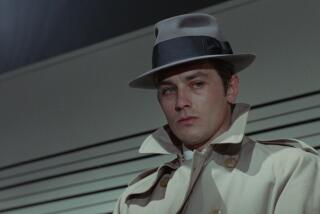Robert Bresson; French Director of Spare, Spiritual Films
French director Robert Bresson, long regarded as one of the cinema’s greatest artists, has died.
French news media reported Tuesday that Bresson died Saturday at the age of 98, but did not release the cause of death or provide information on funeral services or the legendary director’s family.
Between 1943 and 1983, Bresson made just 13 films, but that was enough to secure his position in the pantheon of legendary filmmakers. With a style that was inevitably described as austere, time and again Bresson accomplished on film that most difficult of tasks: evoking the feeling in the viewer that an individual on the screen is in fact undergoing a profound, transcendant spiritual experience. Such was the power of Bresson’s vision that the individual might be a pickpocket or Joan of Arc. Or even, on a symbolic level, a donkey.
In Europe he was eulogized as a director whose sparse and very personal style was the antithesis of the Hollywood blockbuster filmmaker.
“The disappearance of Robert Bresson leaves world cinema an orphan,” said a statement issued by the Cannes Film Festival. “Bresson felt like no one else the importance of the relationship between images, between realism and abstraction, the soul and matter, sounds and looks.”
The doyen of European filmmakers, Portuguese director Manoel de Oliveira, 90, praised Bresson as “the auteur of a very special body of work, for it was different from all the others; he did what he wanted to do without worrying about fashions.”
One French television channel changed its programming to air one of Bresson’s movies Tuesday evening. Prime Minister Lionel Jospin praised Bresson as a master of the filmmaking art whose “atypical and demanding works marked numerous generations of movie lovers.”
Through his work, “he helped us to love the cinema,” a statement from Jospin’s office said.
“The Diary of a Country Priest” (1950), from the Georges Bernanos novel, is perhaps his finest film. It charts the excruciating progress of a young priest toward saintliness. Sickly and of an ascetic nature, he is ill-suited to the grimly provincial parish to which he is assigned. His faith as well as his health begins to disintegrate, though he is encouraged when he succeeds in reconciling the leading local aristocrat to God, but this is just the beginning of his trials. Under Bresson’s direction, Claude Laydu’s face becomes a stoic expression of the priest’s growing agony, both spiritual and physical.
Jean Cocteau wrote the dialogue for Bresson’s film “Les Dames du Bois de Boulogne” (1945), adapted from an incident in a Denis Diderot novel, a classic study of a woman’s revenge. Set in France during the Occupation, “Les Dames” stars the late Maria Casares as Helene, who is advised by a friend that her lover (Paul Bernard) no longer loves her. She says to him in jest that she would like to end their affair--only to find to her horror that he expresses relief. Helene and those she manipulates so ruthlessly could easily be satirized, but Bresson views them with a detached compassion that allows us to see them as almost noble rather than frivolous. “Les Dames” suggests that it is in times of crisis and despair that traditional values are put to the test.
Starting in 1956, Bresson made four remarkable films over a 15-year period. With “A Man Escaped” (1956), Bresson, with immediacy and economy yet great attention to details, told of an imprisoned member of the French Resistance (played by Francois Leterrier, who went on to an acting and directing career), who puts into action his intricate and resourceful plan of escape once he learns he is condemned to die. He is like all of Bresson’s heroes, who are sober, essentially solitary figures subject to severe tests through which they attain a state of grace, or barring that, some greater truth. The film garnered him a best director award at the Cannes Film Festival.
In “Pickpocket” (1959), Michel, played by Martin Lassalle, knows he must inevitably be caught, but at the same time cannot let loose of the one thing that gives his life both meaning and pleasure. The film develops a relationship between policeman and suspected criminal much like the one in Dostoevsky’s “Crime and Punishment.” Without realizing it, Michel is on a spiritual quest in which crime becomes a path to redemption.
Whereas Carl Theodor Dreyer appealed to the emotions with his “Passion of Joan of Arc,” Bresson appealed to the intellect with his terse, 65-minute, documentary-style courtroom drama, “The Trial of Joan of Arc” (1962), in which his Maid of Orleans (Florence Carrez), typically for Bresson, has a capacity for endurance combined with a lack of self-pity.
“Au Hasard, Balthazar” (“By Chance, Balthazar”) (1966) is one of Bresson’s finest, most demanding films, a remorseless, fascinating allegory that hinges upon a donkey being passed from owner to owner in a drab provincial town. Bresson goes way beyond the obvious man’s cruelty to animals as a metaphor to suggest mankind’s infinite capacity for selfishness, greed, ignorance and hypocrisy, as revealed in the donkey Balthazar’s various owners.
No director as rigorous and idiosyncratic as Bresson, who was a handsome, aristocratic-looking man with silver-white hair, could be expected to have the influence on Hollywood filmmakers of an Akira Kurosawa, for example, or a Federico Fellini. But he did influence screenwriter and director Paul Schrader deeply, both as a film theorist and as a filmmaker. Among Schrader’s films, “American Gigolo” (1980) reflects Bresson’s influence the most strongly, as Richard Gere, in the title role, develops an increasing longing for spiritual redemption the more he succeeds as a paid lover of wealthy women.
Not much is known of Bresson’s youth. and until recently he was believed to have been born in 1901 in the Auvergne. A devout Catholic, he studied philosophy and painting at the Beaux Arts but was soon drawn to the cinema, becoming a screenwriter. He became a prisoner of war in Germany in March 1940, and after repatriation to France in June 1941, he began work on his first film as a director as well as a writer, “Les Anges du Peche” (“Angels of Sin”) (1943), set in a convent and said to be a portent of all the films that were to follow.
As the years passed Bresson continued experimenting in his style and concerned himself increasingly with the challenges facing young people. He ended his career with the terse, bristling “L’Argent,” in which the refusal of a Parisian playboy’s rich father to give him an allowance has a domino-like effect. Inspired by a Tolstoy short story, the film is neither a demonstration of the axiom that money is the root of all evil nor a Marxist tract. Instead, the plight of an innocent man falsely accused of knowingly passing phony money evolves into a contemplation of free will and fate.
In the years of professional inactivity that followed “L’Argent,” Besson’s reputation grew stronger with revivals of his films and retrospectives of his career taking place worldwide. In 1975 Bresson wrote “Notes on Cinematography,” revealing his thoughts on filmmaking. Yet he was fond of quoting painter Paul Cezanne: “I paint, I work, I think of nothing.”
More to Read
Only good movies
Get the Indie Focus newsletter, Mark Olsen's weekly guide to the world of cinema.
You may occasionally receive promotional content from the Los Angeles Times.










